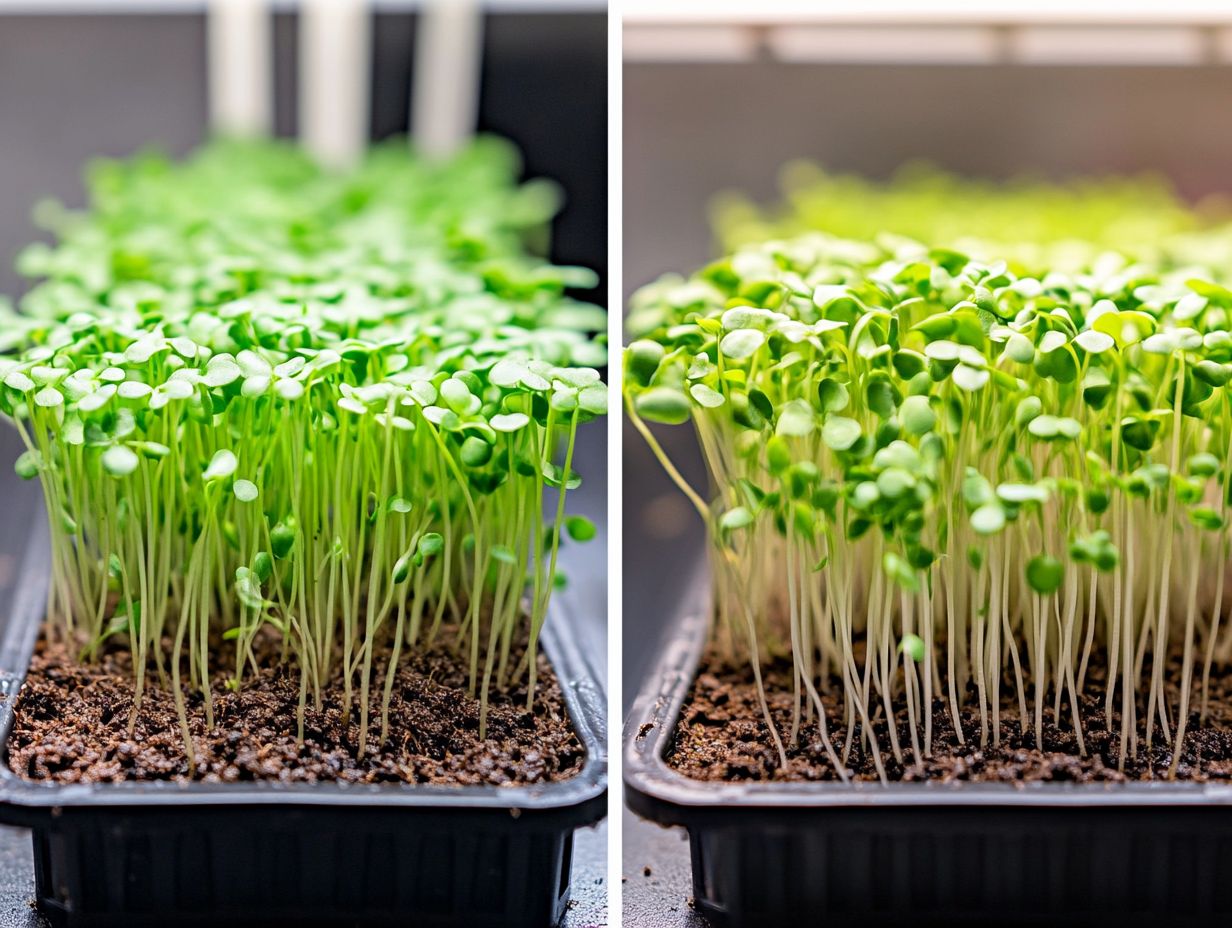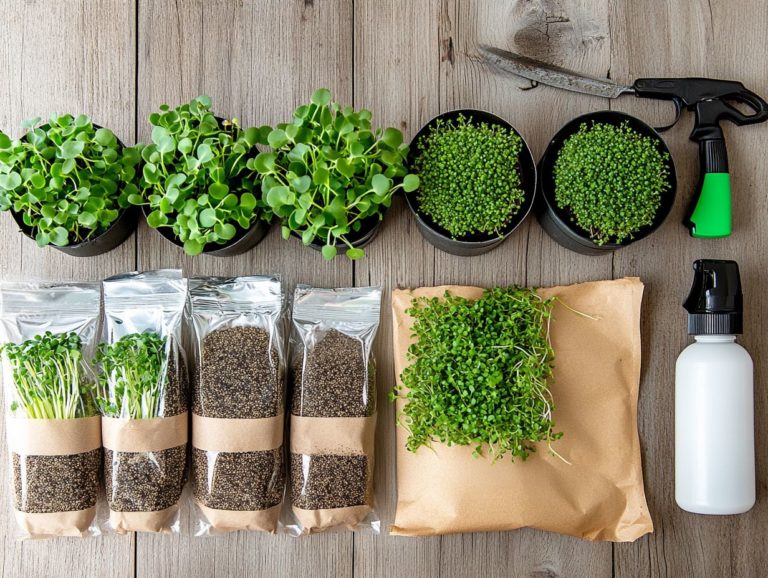Comparing Hydroponic vs. Soil for Microgreens
Microgreens are tiny, nutrient-dense plants that have captured the attention of the cooking world. With an impressive variety of types and flavors, these miniature greens elevate your dishes while delivering remarkable health benefits.
Let s explore what microgreens are, highlight their nutritional advantages, and outline the best methods for cultivating them whether in soil or through hydroponics (growing plants without soil, using nutrient-rich water).
You ll discover the pros and cons of each approach, receive valuable tips for getting started, and learn essential practices to ensure your microgreens flourish.
Embark on this journey to enrich your plate with vibrant greens and learn about the various seed varieties available!
Contents
- Key Takeaways:
- What are Microgreens?
- Benefits of Growing Microgreens
- Hydroponic vs. Soil for Growing Microgreens
- Considerations for Choosing a Growing Method
- How to Get Started with Hydroponic or Soil Microgreens
- Tips for Successful Microgreen Growth
- Frequently Asked Questions
- What is the difference between growing microgreens in hydroponic systems and in soil?
- Which method is more efficient for growing microgreens: hydroponics or soil?
- Do microgreens grown in hydroponic systems have a different taste compared to those grown in soil?
- How does the growth rate of microgreens differ between hydroponics and soil?
- Which method is more cost-effective for growing microgreens: hydroponics or soil?
- Are there any factors to consider when deciding between hydroponic and soil for growing microgreens?
Key Takeaways:

- Hydroponic and soil methods both have pros and cons for growing microgreens. Think about your budget, available space, and time when choosing a growing method.
- Microgreens are packed with nutrients and can be grown in various ways. Experiment with different types to find your favorites.
- For successful microgreen growth, pay attention to proper setup, supplies, and best practices. Avoid common mistakes like over-watering or using contaminated soil to ensure healthy plants.
What are Microgreens?
Microgreens are young, edible plants that you can harvest at an impressively early stage usually within just 7 to 21 days after germination. You’ll discover a variety of types, including flavorful choices like Arugula, Basil, and Broccoli.
Many indoor gardeners cultivate these diminutive greens, drawn by their rich nutritional benefits. Not only do these tiny wonders bring vibrant colors to your dishes, but they also deliver a concentrated nutrient punch, offering a plethora of health advantages. It s no wonder they ve become a favored ingredient in modern cooking.
Definition and Common Types
Microgreens are those delightful young plants you harvest just after their first true leaves appear, showcasing a variety of seed options like Tatsoi, Sunflower, and Pea.
These vibrant greens can be grown indoors or in compact outdoor spaces, making them an enticing choice for urban gardeners and health enthusiasts alike. Each type of microgreen, whether it s the peppery kick of arugula or the gentle sweetness of broccoli, brings its own unique taste and texture to the table, catering to a range of culinary preferences.
Beyond their culinary charm, these tiny powerhouses are brimming with nutrients, including vitamins A, C, E, and K, as well as antioxidants that can play a significant role in enhancing your balanced diet. Their straightforward cultivation and rapid growth make them an ideal option for anyone interested in indoor gardening, making microgreens a superb choice for both novice and seasoned gardeners.
Benefits of Growing Microgreens
Growing microgreens presents a wealth of advantages, ranging from heightened nutritional benefits to effortless accessibility for home gardeners eager to elevate their diets.
These vibrant greens are not merely delightful enhancements to your meals; they are a powerhouse of vitamins, minerals, and antioxidants that bolster overall health.
Whether you choose to source them from a reputable retailer like True Leaf Market or cultivate them in your own kitchen, microgreens are a fun and healthy addition to any culinary pursuit.
Nutritional Value and Versatility
Microgreens are celebrated for their remarkable nutritional value, often boasting higher concentrations of vitamins and minerals than their mature counterparts.
These diminutive greens, including varieties like arugula, radish, and basil, pack an impressive punch in a tiny package, making them a favored choice for those who prioritize their health. They not only elevate your dishes with vibrant colors and enticing flavors but also deliver a wealth of nutrients, such as vitamins C, E, and K, along with essential minerals like calcium and magnesium.
Research indicates that certain microgreens can provide up to 40 times the nutrients of fully grown vegetables. It s no surprise that they re becoming increasingly popular in salads, smoothies, and even gourmet dishes. Their versatility knows no bounds, effortlessly garnishing proteins or enhancing wraps, and offering an easy way to elevate the nutritional profile of your meals.
Hydroponic vs. Soil for Growing Microgreens

When you think about the best medium for growing microgreens, you may weigh the benefits of hydroponics against traditional soil methods. Hydroponic systems create a clean environment that can boost growth rates significantly.
On the other hand, soil provides the natural nutrients needed for strong microgreen development.
Pros and Cons of Each Method
Both hydroponics and soil cultivation have unique advantages and drawbacks affecting yield and maintenance.
Hydroponic systems often result in higher yields due to precise nutrient control and optimized environments. For instance, using fiber pads ensures consistent moisture levels, essential for rapid growth.
Soil-based methods offer a more natural approach. They can enhance flavor profiles due to diverse microorganisms present, but they also risk introducing pests and diseases.
By evaluating these factors, you can determine the best approach to maximize both yield and quality of your microgreens.
Considerations for Choosing a Growing Method
Choosing the right method for your microgreens requires thoughtful consideration of key factors like cost, available space, and time commitments.
As an indoor gardener, weigh the advantages of hydroponics against traditional soil-based methods.
Consider aspects such as initial setup costs, ongoing maintenance, and environmental conditions that could impact growth. Understanding these elements paves the way for a successful and rewarding gardening experience.
Cost, Space, and Time Considerations
Cost, space, and time are critical factors in your decision-making process. Understanding these elements will enhance your journey into indoor gardening.
Cost is a major concern. While investing in quality seeds, soil, and appropriate lighting can yield impressive results, the initial expenses might feel overwhelming.
Think about your available space. Whether you re using a sunlit windowsill or a dedicated shelf, maximizing vertical space can greatly impact your success.
The beauty of microgreens lies in their speedy growth. They are typically ready for harvest in just two to three weeks, giving you that instant gratification of fresh greens.
With thoughtful planning and smart resource management, you can cultivate a thriving microgreen garden that elevates your culinary adventures and enriches your lifestyle.
How to Get Started with Hydroponic or Soil Microgreens
Starting your journey with microgreens, whether through hydroponics or soil, requires gathering the right supplies and creating an ideal environment for growth.
As an indoor gardener, you can choose from a range of specialized growing kits designed for microgreens or customize your setup using seed trays, nutrient solutions, and suitable growing media.
It’s crucial to understand the specific requirements for germination and growth, as this knowledge will set the foundation for a successful experience.
With the right setup and some planning, you ll be on your way to enjoying fresh microgreens in no time!
Supplies and Setup

To successfully grow microgreens, you’ll need essential supplies like seed trays, nutrient solutions, and suitable growing media.
Your choice of cultivation method will greatly impact your success. If you choose soil, a high-quality potting mix enriched with organic matter is vital. This provides necessary nutrients for healthy growth.
If you prefer growing without soil, using hydroponics means you’ll need a nutrient solution combined with a growing medium like coconut coir or rock wool. These options allow for efficient nutrient absorption.
Regardless of the method, providing ample light whether from natural sunlight or specialized grow lights is crucial. It’s also important to maintain a controlled temperature. Proper air circulation is essential as well; it prevents mold and supports healthy growth.
Tips for Successful Microgreen Growth
Successful microgreen growth relies on your commitment to best practices while avoiding common pitfalls. Focus on proper light exposure, effective water retention, and diligent maintenance.
By using proven techniques and learning from mistakes, you can cultivate high-quality microgreens that thrive indoors.
Best Practices and Common Mistakes to Avoid
Using best practices will supercharge your microgreen success. Avoiding common mistakes can significantly improve germination rates and overall yield.
To achieve the best results, prioritize thoughtful planning and careful attention to your microgreen garden. Adequate light exposure is crucial; these delicate plants flourish under bright, indirect sunlight or with specialized grow lights when natural light is insufficient.
Mastering watering techniques is equally important. Overwatering can invite mold, while underwatering may stunt growth. Consistent monitoring of soil moisture levels and using well-draining soil is essential.
Regular maintenance, including gentle air circulation and consistent temperature control, will nurture young shoots as they develop into flavorful, nutritious greens. Paying attention to these details sets you up for microgreen success.
Frequently Asked Questions
What is the difference between growing microgreens in hydroponic systems and in soil?
Hydroponic systems grow plants using a nutrient-rich water solution, while soil provides natural nutrients and support for plant growth.
Which method is more efficient for growing microgreens: hydroponics or soil?

Efficiency depends on various factors, such as the type of microgreen, growing conditions, and personal preference. Both methods can be equally effective.
Do microgreens grown in hydroponic systems have a different taste compared to those grown in soil?
Microgreens grown in hydroponics might have a milder taste due to the lack of soil and its associated flavors. However, this can vary based on the nutrients in the hydroponic solution.
How does the growth rate of microgreens differ between hydroponics and soil?
Microgreens typically grow faster in hydroponics than in soil. This is because the plants have direct access to essential nutrients, leading to quicker growth.
Which method is more cost-effective for growing microgreens: hydroponics or soil?
Hydroponic systems may have a higher initial setup cost but can save money long-term due to reduced water usage and fewer pest control measures.
Ready to start your microgreen journey? Dive in, experiment, and share your experiences with others!
Are there any factors to consider when deciding between hydroponic and soil for growing microgreens?
Absolutely! When deciding between hydroponic and soil methods for growing microgreens, think about your available space and the delicious flavors you want. Your choices matter, so consider what suits your taste and your setup best!






